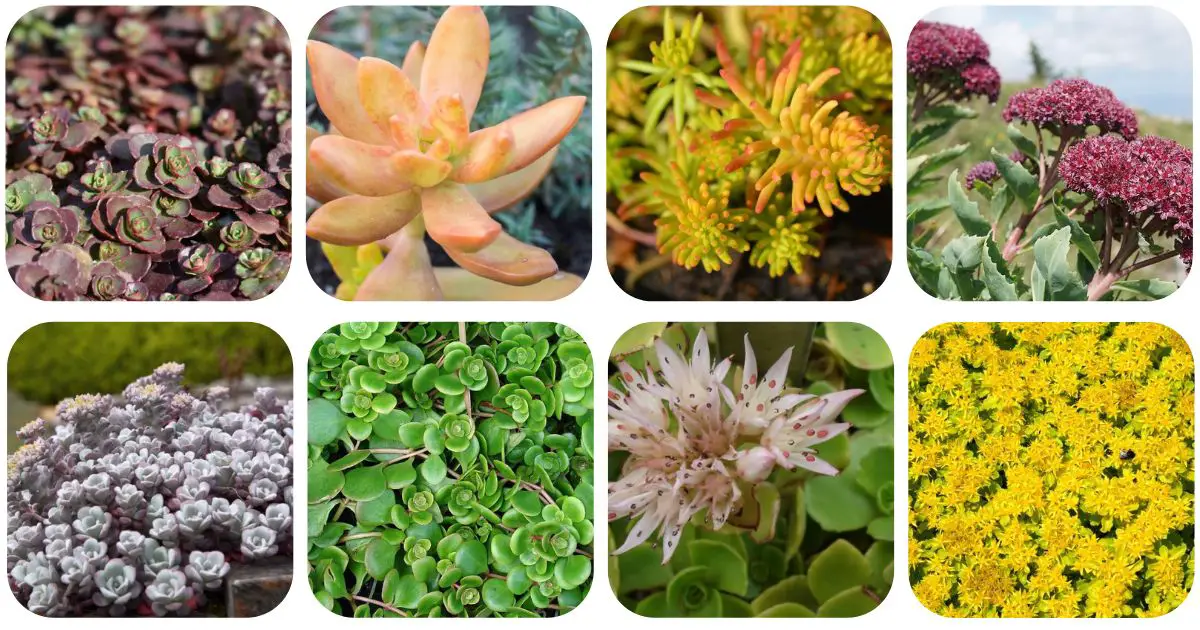Succulents might not be the first plants that come to mind when you’re considering ground cover options, but regardless of your specific needs there’s a good chance there’s a Sedum (stonecrop) that will work for you.
Sedums come in a wide variety of attractive colors, often produce flowers, have a good spreading habit, require minimal maintenance, and are well suited to difficult-to-fill areas, for example where the soil is full of rock or overly sandy.
So, whether you’re looking to reduce your high-maintenance turf, brighten up your winter landscape, or fill the gaps between your pavers where nothing else will grow, there’s a Sedum in this list that will fit the bill.
Sedum Varieties That Can Grow As a Ground Cover
Dragon’s Blood Sedum

| Also Known As | Sedum spurium, Caucasian stonecrop |
| Growing Zone | 4-9 |
| Maximum Height | 6 inches |
| Sun | Full sun preferred, some shade tolerated |
| Water | Drought tolerant |
Perhaps the most spectacular of all the ground cover sedums, Dragon’s Blood is immediately identifiable for its short, beautiful foliage, which is green with red or red edges but turns a brilliant dark red in the fall.
This plant is resistant to drought, cold temperatures, poor soil, disease, insects, and larger pests like deer and rabbits. Best of all, because it is an unusual succulent that is native to the Caucuses, it is well suited to cooler growing zones than most succulents will tolerate.
This plant also propagates easily and spreads well. A mature plant may be up to 18 inches in diameter. With sufficient sunlight, dragon’s blood sedum produces tiny pink flowers and attracts butterflies.
>> You can buy Dragon’s Blood as a seed here at Amazon.
>> Also available as a 2 inch plant here.
Coppertone Sedum

| Also Known As | Sedum nussbaumerianum, Coppertone stonecrop |
| Growing Zone | 10+ |
| Maximum Height | 2-3 feet |
| Sun | Full sun preferred, shade tolerated, but will reduce color |
| Water | Drought tolerant |
Coppertone sedum is a particularly attractive variety of succulent. Indoors they tend to stay small, but outdoors they grow bushy, and up to a few feet tall.
With plenty of sunlight, this plant’s leaves turn a lovely shade of golden yellow or orange, often with rosy edges. An established, mature plant may survive a brief cold snap, but it’s best to provide protection, as these plants are not winter-hardy outside of the warmest growing zones.
Autumn Joy

| Also Known As | Sedum spectabile |
| Growing Zone | 3-9 |
| Maximum Height | 2-3 feet |
| Sun | Full sun preferred |
| Water | Drought tolerant when mature |
This gorgeous tall sedum produces large clusters of pink flowers that gradually turn red as they age. The long-lasting quality of the flowers makes them a popular cultivar of sedum, both with people and butterflies. Moreover, its reddened flowers bring welcome color to drab winter gardens.
These bushy plants spread well, up to a couple of feet in width. They can be propagated easily, and may self-propagate from fallen leaves. If you prefer a shorter and bushier plant, you can prune them in the late spring.
As for its hardiness, they are drought-resistant once established, but may appreciate a little extra water the first few years.
Purple Emperor
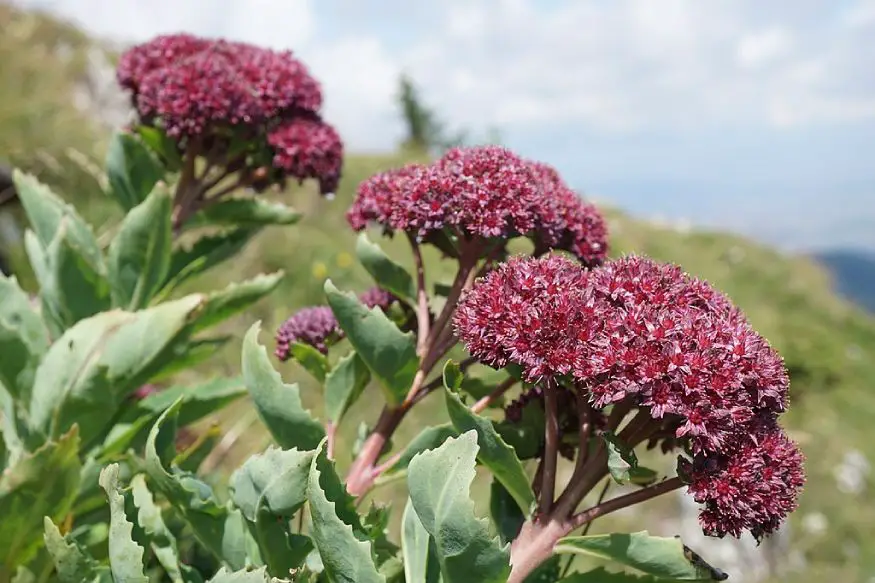
| Also Known As | Sedum telephium |
| Growing Zone | 3-7 |
| Maximum Height | 1.5 feet |
| Sun | Prefers full, tolerates some shade |
| Water | Moderate to low water needs; drought tolerant when mature |
If you’re looking for unusually colorful ground-cover, purple emperor is a great choice. These are upright plants, not creepers, but don’t generally exceed a foot and a half high or wide. You should also provide lots of sunlight and rocky or sandy soil to keep the stems sturdy rather than droopy.
These plants like a little more water than some other sedums. Pruning your plants is also essential since it will stimulate growth and bushing out. The leaves of this plant are a brilliant purple, and it produces large clusters of long-lasting pinkish flowers in the summer and fall.
Because of its striking color and preference for “bad” soil, Purple Emperor is a great choice for filling in sunny spots in your garden where other plants won’t grow.
Red Carpet Stonecrop
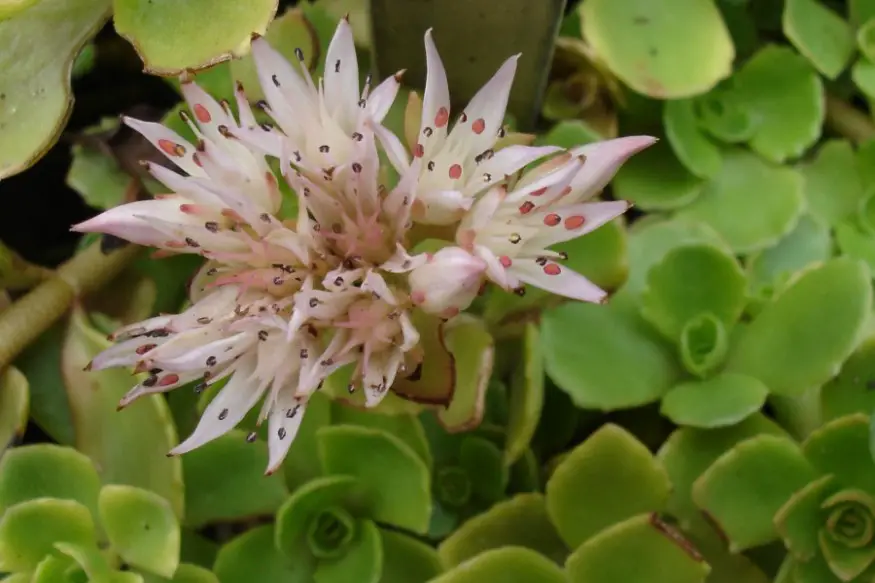
| Also Known As | Sedum spurium |
| Growing Zone | 3-9 |
| Maximum Height | 6 inches (including flowers) |
| Sun | Prefers full sun |
| Water | Drought tolerant |
Perfect for hot gravelly areas next to driveways, or other places where other plants won’t grow, red carpet stonecrop is a nearly bomb-proof ground cover.
This variety forms dense mats of stems and foliage that closely hugs the ground. Its attractive green leaves turn deep red in the fall and winter. During summer, it produces short clumps of pink flowers.
It is also pest-resistant, and attracts birds and pollinators. However, this plant is such a good spreader that it can potentially be slightly invasive in especially suitable environments, so keep an eye on it.
Angelina Stonecrop

| Also Known As | Sedum rupestre |
| Growing Zone | 5-8 |
| Maximum Height | 6 inches |
| Sun | Prefers full sun |
| Water | Drought tolerant |
If you want colorful succulent ground cover, Angelina may be the Sedum for you. This plant has vibrant yellow foliage that brightens up your garden year round, ranging from chartreuse to goldenrod to ultimately turning orange in the fall. During summer, Angelina stonecrop produces long-lasting yellow flowers.
The foliage has an unusual shape, like an evergreen branch with needles. But she is one tough cookie, growing happily in mediocre soil, and heat, whether it’s a humid or dry heat.
These plants spread rather quickly, about a foot in a single season, so they’re perfect for quickly filling in empty spots where other plants won’t grow. Like most of the succulents in our list, this succulent is resistant to pests other than the occasional slug.
Kamchatka sedum

| Also Known As | Sedum kamtschaticum, Kamchatka stonecrop, Orange stonecrop |
| Growing Zone | 3-8 |
| Maximum Height | 6 inches |
| Sun | Full sun preferred |
| Water | Drought tolerant |
This short spreader is from Siberia, so it’s perfect for gardeners looking for an easy to grow ground cover that will thrive despite cold winter conditions. Kamchatka produces abundant short green foliage, which isn’t anything special compared to some of the showier sedums on our list.
However, throughout the summer it produces short clusters of pale yellow flowers, which turn into reddish fruit in the fall. Unlike many of the sedums we’ve listed, which maintain healthy foliage year round, kamchatka sedum tends to die back in the winter when planted in colder growing zones. However, it will return in the spring, assuming it is planted in an area with sufficient sunlight and good drainage.
Chinese Stonecrop
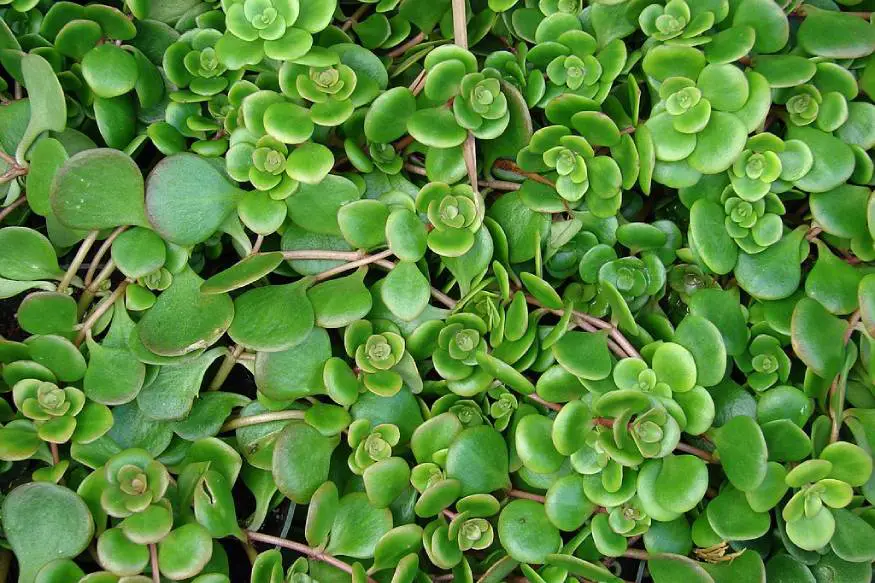
| Also Known As | Sedum tetractinum, Coral Reef Sedum |
| Growing Zone | 4-8 |
| Maximum Height | 2-4 inches |
| Sun | Full sun or partial shade |
| Water | Drought tolerant |
The delightfully petite foliage of this plant maxes out at 2-4 inches, yet each plant quickly spreads to cover an area about a foot in diameter. Because it is so short, this is a great sedum to use in areas around paving stones, as well as in rock gardens or virtually anywhere else. It is very resilient, requiring minimal water, minimal organic matter in the soil, and a bit less sun than many of the other sedum options.
The leaves of this plant are usually a rather ordinary green, but in the fall they turn more golden or reddish. It produces yellow flowers in the summer that attract butterflies. It is a bit more subtle than some of the other super-showy sedums, but it is extremely functional and quite attractive.
Broadleaf Stonecrop Carnea
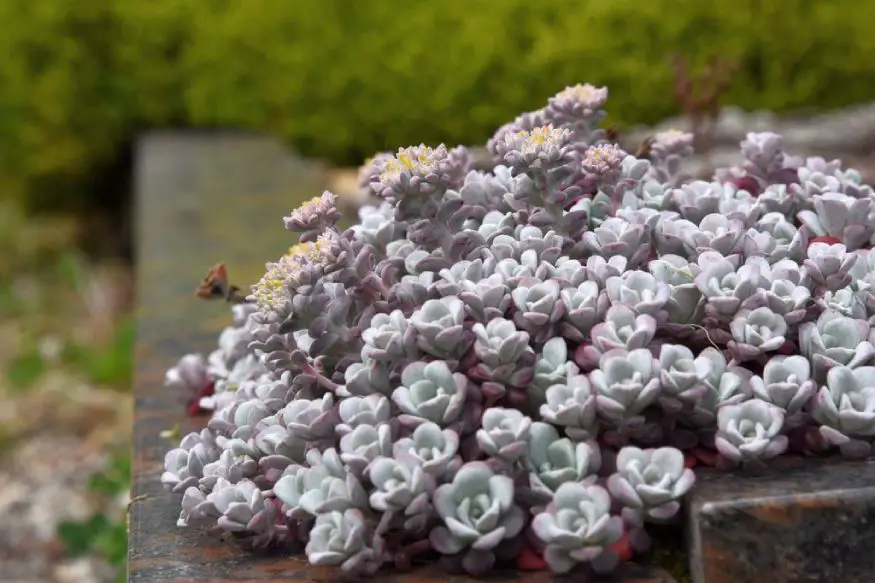
| Also Known As | Sedum spathulifolium, Sedum Carnea |
| Growing Zone | 5-9 |
| Maximum Height | 2-4 inches |
| Sun | Prefers full sun, tolerates some shade |
| Water | Drought tolerant |
There are a bunch of wonderful broadleaf stonecrop cultivars, which come in a wide range of leaf and flower colors. One great option is Carnea.
This plant is nice and short, growing dense mats of silvery rosettes with purple to rose-colored accents, and turns a darker red in the winter. In the summer it produces yellow flowers. This plant spreads well, but is not invasive. Plus, it grows well in poor, rocky or very sandy soils, and rarely if ever needs watering.
This plant is native to northern California and Oregon, and does well in similar climates. The depth of its coloration will vary depending on the season and the specific environment where it is grown.
Cape Blanco Sedum
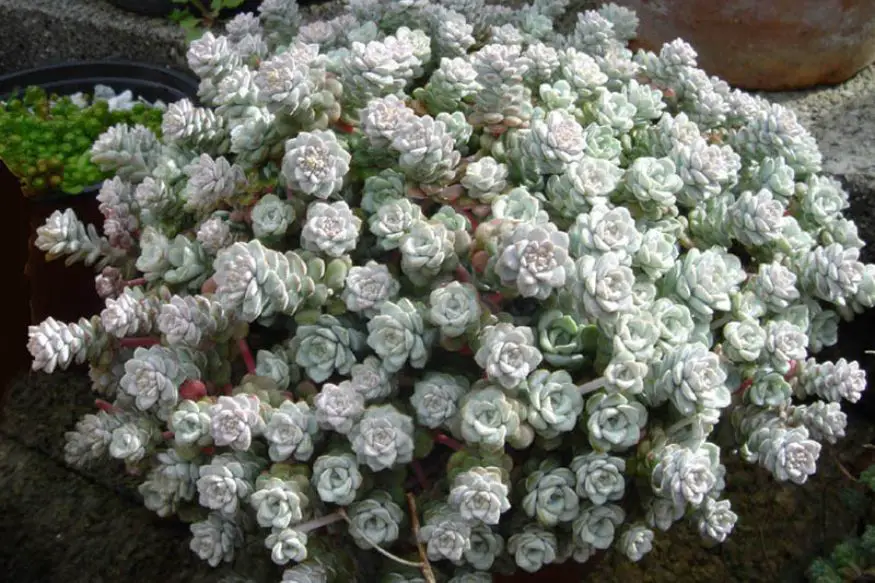
| Also Known As | Sedum spathulifoliuma |
| Growing Zone | 5-9a |
| Maximum Height | 2 inches |
| Sun | Prefers full sun, tolerates some shade |
| Water | Drought tolerant |
This is in a sense the uber ground-cover sedum of all the sedums on our list. Each plant hugs the ground tightly, growing to only two inches tall, but each plant can spread up to two feet in diameter.
The plant’s green leaves are covered in a pale greyish waxy coating that makes it look silvery in the landscape. In the summer, it produces yellow flowers.
This plant is perfect for rock gardens, paver pathways, and other locations with poor soil, as long as there is good drainage. It is very easily propagated by simply breaking off a piece of branch and sticking it into the soil where you want it to take root. It is native to the Pacific Northwest, and can tolerate moderately cold winters.
How To Use Sedum (Stonecrop) as a Groundcover
Sedums are succulents, meaning that they have fleshy leaves that absorb and store large quantities of water. They evolved this capacity due to living in environments where they could not reliably access water using their roots, except after an occasional heavy rain, for example a crevice in a rocky cliffside or in the branch attachment of a tree with heavy foliage.
But, don’t let these elevated examples of growing environments mislead you, Sedum also make excellent ground cover, but knowing where they originate matters, because it affects the kinds of growing conditions they want.
Soil

One thing all sedums have in common is that they prefer well-draining soil.
With other plants, we tend to think that more compost and organic matter is always better, but when it comes to succulents like sedum you want low levels of organic matter and lots of sand and gravel.
Note: If you have soil that is clay-heavy or rich in organic matter, take the time to amend it before you introduce a sedum ground cover.
Adding a bit of sand and gravel to the top few inches of soil, with a clay-dense substrate, is not going to work well either. You really need to make sure that the plant’s roots will not be sitting in soggy soil, to avoid root rot and a variety of other pests and diseases.
Succulents like Sedums also prefer soil that is mildly acidic. You may want to contact your county extension office about getting a soil test if you suspect your soil may be more on the alkaline side.
Container
If you don’t want to have to improve the drainage in your yard, but you do want to grow sedum, consider growing it in planters.
Using a container allows you to bring color and interest to different areas of your garden, depending on the season. It is often the best way to ensure your sedum gets full sun all year and also to encourage its full color expression.
Note: If you live in a growing zone that is not appropriate for your sedum, using a container also allows you to bring your sedum indoors for the winter.
Sedums do well in pots and containers of all sorts, as long as they are given excellent drainage (in terms of both the pot and the potting mix in it). Pay attention to whether you are planting a Sedum with an upright or trailing growth habit, as that will affect what sort of container will work best.
Sun
Sedum thrive in full, direct, full-year sunlight. However, many will tolerate partial shade. If you plant your sedum in shade, you can expect them to be greener (rather than showing golden or red coloration) and they will be floppier. That is part of why they also grow well in hanging pots and tall planters indoors or in areas with shade. The reduced sunlight encourages the plant to have a trailing habit rather than an erect posture.
Water
The water needs of your sedum can vary somewhat with the cultivar. However, most are drought-tolerant, especially after they are well established. In fact, succulents do better with a good soak every once in a while rather than a slow-drip irrigation system.
Size and Spread
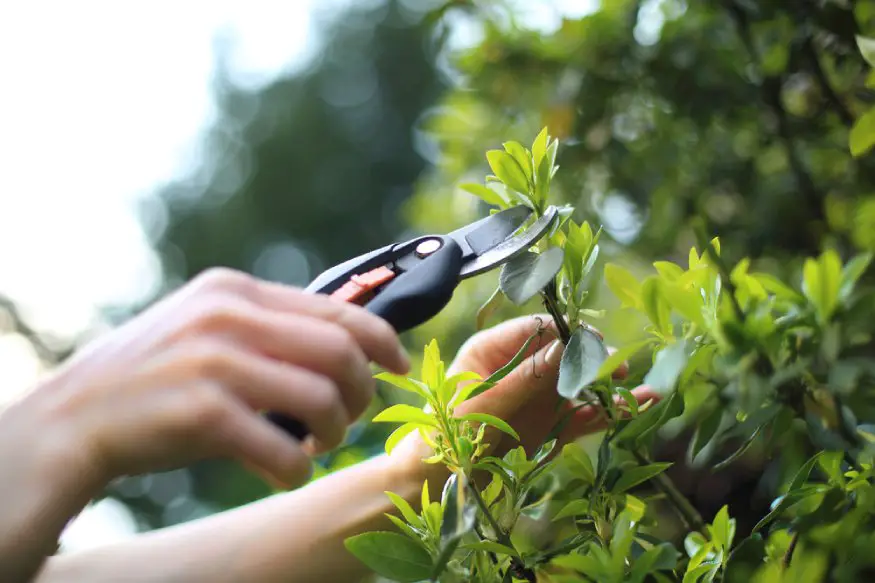
There is wide variation in the height and spread rates of different sedum varieties. However, they can be broken down roughly into tall Sedums and creeping Sedums.
Tall sedums may grow some stems as high as three feet tall. Creeping sedums tend to grow along the ground, at a more turf-like height, maxing out at around six inches tall.
However, even some of the shortest Sedums can cover a foot or two of ground once mature.
Sedums are great at self-propagation. If you prune your succulents back in the spring, you can replant all of the cut ends. You can try our suggested indoor propagation techniques, but the easiest thing is to just stick the cut end into the ground. Not all will take root, but many will. These plants are eager to grow.
Unlike other creeping ground covers and even other species of succulents (like mother of thousands), Sedums are not typically invasive. They are shallow-rooted, and can easily be removed if they do grow outside of their designated area.
Maintenance
One of the best parts of growing Sedums as ground cover is the fact that they are so incredibly low-maintenance. The difference between sedum and grass is night and day.
As long as you plant your Sedum in a suitable location (well draining soil, sufficient sunlight, appropriate growing zone), you don’t need to do much to take care of it. In fact, by failing to clean up fallen branches and leaves, you encourage your Sedum to self-propagate.
Note: Sedum vary in their ability to out-compete other plants, but when they are established they don’t tend to need much weeding.
Generally, the taller sedums can be kept short via pruning. Simply break off taller branches using your fingers. Alternatively, you can use a set of sharp pruning loppers or clippers. Some are even suitable for an annual weed whacking.
Pruning succulents tends to make each stem produce multiple new stems, so the plant becomes fuller and bushier over time. It’s best to prune in the late spring if you want to stimulate new growth, but typically sedums are eager to grow regardless of the circumstances. In our experience they can be pruned or propagated at any time of year with no obvious ill effect.
Covering the Basics with Sedum
Regardless of your growing zone, growing environment, and color preference, you are sure to find a Sedum ground cover that is perfect for a spot in your garden. This list of ten of our favorites barely scratches the surface. So give yourself a break. Replace some turf or high maintenance plants with Sedum, kick back, and let your plants take care of themselves.

